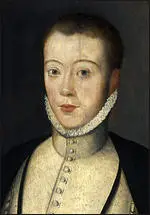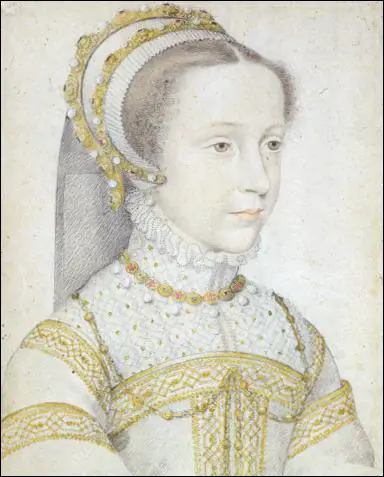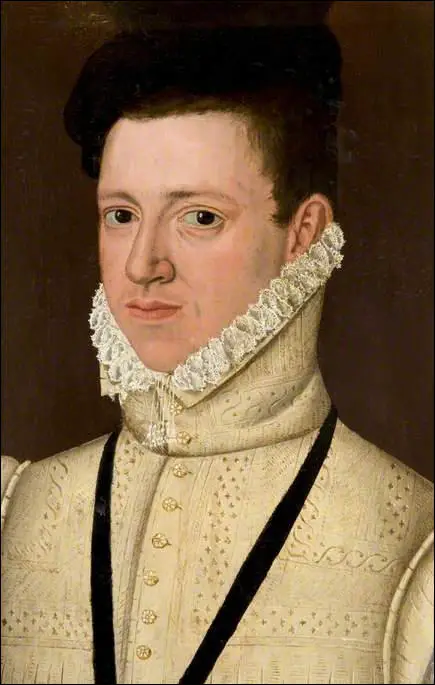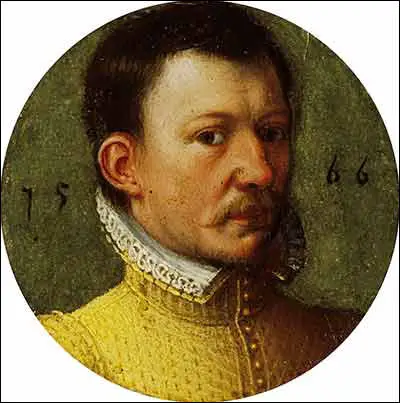Henry Stuart, Lord Darnley

Henrt Stuart, the son of Matthew Stewart, 4th Earl of Lennox (1516–1571) was born at Temple Newsam, near Leeds, on 7th December, 1545. His mother Lady Margaret Douglas, was the daughter of Archibald Douglas, 6th Earl of Angus, and his wife, Margaret Tudor, widow of James IV, king of Scots.
Through his parents he had claims to both the Scottish and English thrones, being descended from both James II of Scotland and Henry VII of England, and parental ambition ensured that he was brought up conscious of his status and his inheritance. "He was educated at home... He was an elegant dancer, and accomplished in singing and in playing the lute; physically he was strong and athletic, a good horseman with a knowledge of weapons and a passion for hunting and hawking; academically he appears to have been an average student for the time, learning Latin and growing up familiar with the Scots, English, and French languages." (1) The Lennox family were Roman Catholic and it was claimed that their supporters may well have been capable of threatening stability in England.
Mary Stuart, the daughter of James V of Scotland and Mary of Guise, lived with the family of King Henri II. She was given a French education and on 4th April 1558, Mary signed a secret agreement bequeathing Scotland and her claim to England to the French crown if she died without issue. Three weeks later she married the king's eldest son, Francis. (2) Although omitted from the will of Henry VIII, she was one of the linel heiresses to the English crown. Henri believed that the marriage could result in a controlling interest in the combined realms of England and Scotland. (3)
Treaty of Edinburgh
On 17th November 1558, Henry VIII's elder daughter, Queen Mary I died. She was succeeded by her sister, Elizabeth. In the opinion of many Catholics, Elizabeth was illegitimate, and Mary Stuart, as the senior descendant of Henry VIII's elder sister, was the rightful queen of England. Henri II of France proclaimed his eldest son and daughter-in-law king and queen of England, and in France the royal arms of England were quartered with those of Francis and Mary. (4)

On 10th July 1559, King Henri II was killed by Gabriel Montgomery during a tournament. Mary's fifteen year old husband became king of France. This development caused concern in England and urged on by William Cecil, Queen Elizabeth ordered an English fleet to cut the sea link between Scotland and France. She also issued instructions for assembling an army and after they invaded in the early months of 1560, negotiations between the countries took place. Under the terms of the Treaty of Edinburgh, signed in July, both France and England agreed to withdraw their forces from Scotland and leave the religious question to be settled by the Scottish Parliament. The body met in August and imposed the Reformation upon Scotland and the celebration of mass was forbidden. (5)
Lord Darnley went to the French Court to congratulate Mary and Francis II of France on their accession and seek help for his father Matthew Stewart, 4th Earl of Lennox, who had been declared guilty of treason and his Scottish estates were forfeited in 1545. Mary did not restore Lennox to his Scottish earldom, but she did give 1,000 crowns to Darnley and invited him to her coronation. (6)
The following year Francis developed a middle ear infection which led to an abscess in his brain. He died on 5th December 1560. His mother, Catherine de Medici, became regent for his ten-year-old brother Charles IX, who inherited the French throne. (7) She spent her period of strict mourning with her grandmother Antoinette. In January 1561, attempts were made to arrange a marriage with Don Carlos, eldest son of Philip II, but in April this was blocked by her mother-in-law.
Marriage to Mary, Queen of Scots
Lord Darnley met Mary, Queen of Scots, on Saturday 17th February 1565, at Wemyss Castle in Scotland. Soon afterwards, arrangements were made for the two to marry. Elizabeth was totally against the match because it would unite two claims on the throne. Any children of the marriage would inherit an even stronger, combined claim. At first Elizabeth was confident that she would block it because Darnley was an English subject, and his parents were her dependants with lands in England. (8) However, they married at Holyrood Palace on 29th July 1565, even though both were Catholic and a papal dispensation for the marriage of first cousins had not been obtained. (9)

Mary's marriage to a leading Catholic resulted in Mary's half-brother, James Stuart, the Earl of Moray, to join with other Protestant lords in open rebellion. Mary and her forces and Moray and the rebellious lords roamed around Scotland without ever engaging in direct combat. Mary's numbers were boosted by the return of James Hepburn, 4th Earl of Bothwell, from exile in France. Mary's forces were greatly superior, and unable to obtain sufficient support, Moray left Scotland for asylum in England. (10)
Mary became pregnant. However, the marriage was not a happy one. According to Elizabeth Jenkins: "Marriage with a Queen and one of the most beautiful of women had been too much for Darnley's weak head. His brainless arrogance had been so much increased that he did not treat even his wife with courtesy. Mary's passion was soon extinct, and her coldness and dislike roused him to the fatuous self-assertion that had been fostered by his mother." (11)
Murder of David Rizzio
Darnley became jealous of David Rizzio, who had replaced him as her most important political advisor. According to his biographer, Rosalind K. Marshall "he was an ugly little man, full of his own importance, with an expensive taste in clothes... but Mary evidently felt that she could trust him. As her secretary he was constantly in her company... At the same time he did everything he could to enhance his own position, and the courtiers soon came to realize that if they wished for favours, they would have to bribe Seigneur Davie, as he was known." (12)
Thomas Randolph, the English Ambassador to Scotland, reported to William Cecil that Rizzio was a growing influence on Mary. It was decided to spread rumours that Riccio was having an affair with the Queen of Scots. It was even suggested that Rizzio was the real father of Mary's unborn child. (13) Darnley decided to join forces with a group of protestant lords who shared a dislike of Rizzio.
On 9th March 1566, about seven o'clock in the evening, Mary was at supper with Riccio in the little room adjoining her bedchamber at Holyroodhouse. "Suddenly Darnley marched in, sat down beside Mary, and put an arm round her waist, chatting to her with unaccustomed geniality. She had scarcely replied when the startling figure of Patrick Ruthven, Lord Ruthven, appeared in the doorway, deathly pale and wearing full armour... The queen rose to her feet in alarm. Terrified, Riccio darted behind her, to cower in the window embrasure, clinging to the pleats of her gown. The royal attendants sprang forward to take Ruthven, but he pulled out a pistol and waved them back. At the same moment the earl of Morton's men rushed into the supper chamber, the table was overturned... While Andrew Ker of Fawdonside held his pistol to the queen's side, George Douglas, Darnley's uncle, snatched Darnley's dagger from his belt and stabbed Riccio. According to Mary's own description of events, this first blow was struck over her shoulder... On Darnley's orders his body, with fifty-six stab wounds, was hurled down the main staircase, dragged into the porter's lodge, and thrown across a coffer where the porter's servant stripped him of his fine clothes." (14)
It is claimed that when Mary was told the news that Riccio was dead, she apparently dried her eyes and said "No more tears now. I will think upon revenge". Riccio was buried hastily in a cemetery outside Holyrood Abbey. However, later, Mary had his body exhumed and placed in the royal vault in the abbey. She then appointed his young brother Joseph Riccio to take his place as her French secretary.
Death of Lord Darnley
Mary now joined forces with James Hepburn, 4th Earl of Bothwell. She pardoned Lord Moray and the other exiles, and the people involved in the assassination of David Rizzio fled to England. Mary was now back in charge. In April 1566, Mary took up residence in Edinburgh Castle in order to await her child's birth, and on 19th June, after a difficult labour, Prince James was born. Queen Elizabeth was furious when a poet based in Paris, described James as prince of Scotland, England, France, and Ireland. (15)
After the birth of their son the couple lived apart. Lord Darnley was taken ill (officially with smallpox, possibly in fact with syphilis) and was convalescing in a house called Kirk o' Field. Mary visited him daily, so that it appeared a reconciliation was in progress. In the early hours of the morning on 10th February, 1567, an explosion devastated the house. "Darnley had become the victim of one of the greatest unsolved murders in history. The bodies of Darnley and his servant were found under a tree in the garden, with a chair, a dagger, a coat, and a cloak beside them. There was no sign of explosion on the bodies, nor had they been stabbed, shot, strangled, or beaten. They had probably been suffocated, but the full story of events remains a mystery." (16)
Elizabeth wrote to Mary: "I should ill fulfil the office of a faithful cousin or an affectionate friend if I did not... tell you what all the world is thinking. Men say that, instead of seizing the murderers, you are looking through your fingers while they escape; that you will not seek revenge on those who have done you so much pleasure, as though the deed would never have taken place had not the doers of it been assured of impunity. For myself, I beg you to believe that I would not harbour such a thought." (17)
One of Mary's biographer's, Julian Goodare, claims that the murder was an "abiding historical whodunnit, generating a mass of contradictory evidence, and with a large cast of suspects since almost everyone had a motive to kill him." He points out that historians are divided about Mary's involvement in the killing. "The extreme anti-Mary case is that from late 1566 onwards she was conducting an illicit love affair with Bothwell, with whom she planned the murder. The extreme pro-Mary case is that she was wholly innocent, knowing nothing of the business. In between these two extremes, it has been argued that she was aware in general terms of plots against her husband, and perhaps encouraged them." (18)

According to the depositions of four of Bothwell's retainers, he had been responsible for placing the gunpowder in Darnley's lodgings and had returned at the last moment to make sure that the fuse was lit. According to his biographer, that there is little doubt that Bothwell played a principal part in the murder. (19) Mary's critics point out that she made no attempt to investigate the crime. When urged to do so by Darnley's father, she replied that Parliament would meet in the spring and they would look into the matter. Meanwhile she gave Darnley's clothes to Bothwell. The trial of Bothwell took place on 12th April, 1567. Bothwell's men, estimated at 4,000, thronged the streets surrounding the court-house. Witnesses were too frightened to appear and after a seven-hour trial, he was found not guilty. A week later, Bothwell managed to convince more than two dozen lords and bishops to sign the Ainslie Tavern Bond, in which they agreed to support his aim to marry Mary. (20)
Student Activities
Henry VIII (Answer Commentary)
Henry VII: A Wise or Wicked Ruler? (Answer Commentary)
Henry VIII: Catherine of Aragon or Anne Boleyn?
Was Henry VIII's son, Henry FitzRoy, murdered?
Hans Holbein and Henry VIII (Answer Commentary)
The Marriage of Prince Arthur and Catherine of Aragon (Answer Commentary)
Henry VIII and Anne of Cleves (Answer Commentary)
Was Queen Catherine Howard guilty of treason? (Answer Commentary)
Anne Boleyn - Religious Reformer (Answer Commentary)
Did Anne Boleyn have six fingers on her right hand? A Study in Catholic Propaganda (Answer Commentary)
Why were women hostile to Henry VIII's marriage to Anne Boleyn? (Answer Commentary)
Catherine Parr and Women's Rights (Answer Commentary)
Women, Politics and Henry VIII (Answer Commentary)
Cardinal Thomas Wolsey (Answer Commentary)
Historians and Novelists on Thomas Cromwell (Answer Commentary)
Martin Luther and Thomas Müntzer (Answer Commentary)
Martin Luther and Hitler's Anti-Semitism (Answer Commentary)
Martin Luther and the Reformation (Answer Commentary)
Mary Tudor and Heretics (Answer Commentary)
Joan Bocher - Anabaptist (Answer Commentary)
Anne Askew – Burnt at the Stake (Answer Commentary)
Elizabeth Barton and Henry VIII (Answer Commentary)
Execution of Margaret Cheyney (Answer Commentary)
Robert Aske (Answer Commentary)
Dissolution of the Monasteries (Answer Commentary)
Pilgrimage of Grace (Answer Commentary)
Poverty in Tudor England (Answer Commentary)
Why did Queen Elizabeth not get married? (Answer Commentary)
Francis Walsingham - Codes & Codebreaking (Answer Commentary)
Codes and Codebreaking (Answer Commentary)
Sir Thomas More: Saint or Sinner? (Answer Commentary)
Hans Holbein's Art and Religious Propaganda (Answer Commentary)
1517 May Day Riots: How do historians know what happened? (Answer Commentary)
Primary Sources
(1) Elizabeth Jenkins, Elizabeth the Great (1958)
The situation between Mary and Darnlcy had gone from bad to worse; Lethington told her ambassador in France that it was "a heart-break" to her to be tied to such a husband with no prospect of an "outgait". By 1567 the Protestant Lords had decided that some outgait must and should be found to release Mary and themselves. The matter was discussed at Craigmillar Castle between the Queen and a representative body of nobles, including Lethington, Morton, Mar and Mary's evil genius, the Earl of Bothwell. Murray was not present. Mary refused to consider divorce in case it threw doubts on the legitimacy of her son, and the Lords told her to leave the matter to them; she agreed to do so, with the elegant stipulation that nothing must be done that would stain her honour.
The terrific explosion that roused Edinburgh in the early hours of February 11 did more than blow up the house in which the invalid Darnley was lying: it brought down Mary's ambition in ruins. The charges of promiscuous immorality brought against her derived merely from the Presbyterian terror of gaiety, music and fine clothes; but once she had conceived a passion, her determination to gratify it was uncontrollable. Her first husband was a sickly child, her second was Darnley. Her infatuation with Bothwell was but too natural, but it was disastrous. Had she merely accepted the help of the Lords in freeing herself of Darnley, she could have begun afresh, secure in the tolerance of mutual blackmail; but the Lords had not given their support to Bothwell in these compromising measures, to have him, rapacious, arrogant and detested, put over their heads and made, at last, their King. When Mary insisted upon doing this, they turned on her. They had discussed the murder, they knew who was to do it; but the wife's guilt was greater than the councillors', and to Mary's endless anger, this was the aspect placed before the world.
Student Activities
Codes and Codebreaking (Answer Commentary)
Francis Walsingham - Codes & Codebreaking (Answer Commentary)
Why did Queen Elizabeth not get married? (Answer Commentary)
